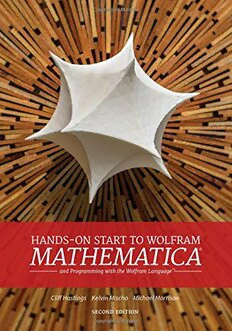Table Of ContentHANDS-ON START TO WOLFRAM
MATHEMATICA®
and Programming with the Wolfram Language™
SECOND EDITION
Cliff Hastings Kelvin Mischo Michael Morrison
Champaign
����� �� ��������
Introduction vii
���� �
THECOMPLETEOVERVIEW1
Chapter1 TheVeryBasics 3
Chapter2 ASampleProjectinMathematica 11
Chapter3 InputandOutput 21
Chapter4 WordProcessingandTypesetting 43
Chapter5 PresentingwithSlideShows 59
Chapter6 FundamentalsoftheWolframLanguage 73
Chapter7 CreatingInteractiveModelswithaSingleCommand 93
Chapter8 SharingMathematicaNotebooks 115
Chapter9 FindingHelp 125
���� ��
EXTENDINGKNOWLEDGE 133
Chapter10 2Dand3DGraphics 135
Chapter11 VisualizingData 157
Chapter12 StylingandCustomizingGraphics179
Chapter13 CreatingFiguresandDiagramswithGraphicsPrimitives 213
Chapter14 AlgebraicManipulationandEquationSolving 233
Chapter15 Calculus 245
Chapter16 DifferentialEquations 261
Chapter17 LinearAlgebra 271
Chapter18 ProbabilityandStatistics 289
Chapter19 ImportingandExportingData 305
Chapter20 DataFilteringandManipulation 327
Chapter21 WorkingwithCuratedData 359
Chapter22 UsingWolfram|AlphaDatainMathematica 393
Chapter23 StatisticalFunctionalityforDataAnalysis 419
Chapter24 CreatingPrograms 437
Chapter25 CreatingParallelandGPUPrograms 459
Index 477
INTRODUCTION
How to Use This Book
Create Examples while Reading
Thisbookismeanttobeanactivecompanionduringtheprocessoflearninghowtouse
Mathematica®.Themainbodyofthetextwillcertainlyprovideinsightsintohow
Mathematicaworks,buttheexamplesshouldberetypedasastartingpointforindividual
exploration.Eachchaptercontainsdiscussion,tipsandadescriptionofMathematica
functionality,alongwithactualexamplesthatserveasstartingpoints.Eachchapterends
withadditionalexercisestoemphasizecomprehension,whichcanbeusedasanassign-
menttostudentsorsimplytoworkthroughonyourown.
Nomatterwhatformatthisbookisviewedin,itisrecommendedthatreadershave
MathematicaonthedesktoporMathematicaOnline™ immediatelyaccessibletotype
theexamplesandworkthroughtheexercises.Itisrecommendedthatasreaderswork
throughthebook,theysaveanewfileforeachchapterinWolframNotebook™ format
(.nb),eitherlocallyorintheWolframCloud™,forfuturereference.
(cid:1) Anytextinthistypeofstyledboxismeanttobeatipbytheauthors.Theadviceis
meanttopassalongexperiencegainedfromteachingthousandsofpeoplehowto
useMathematica.
Part I: The Complete Overview Is Required Reading
AllnewMathematicausersshouldworkthroughchaptersonethroughninefirsttoobtain
thenecessarybasisofknowledgefortherestofthebook.Thesechapterswillbeofvalueto
intermediateMathematicausersbyfillingingapsinknowledgethatcanresultfromusing
Mathematicaonlyforanarrowlydefinedsetoftasks,orbybroadeningthehorizonsof
userswhomayhavelearnedMathematicafromanolderversion.
���
������������
Part II: Extending Knowledge Is Suggested Reading
OncePartI:TheCompleteOverviewisfinished,therestofthechapterscanbereadin
orderasacompletebookorcanbereadintheorderthatmostappealstothereader.
Chapter1:TheVeryBasicsisdesignedtogiveyouexperiencewithtypingcommandsin
Mathematica.Knowingwhatcommandstouseandwhentousethosecommandswillbe
discussedinsubsequentchapters;thepurposeofthefirstchapterissimplytoprovide
initialpracticeandimmersioninusingMathematica.
Chapter2:ASampleProjectinMathematicaismeanttoshowthescopeofMathematica
andhowitcanbeappliedtoquicklyexploreareal-worldproblem.Thegoalofthechapter
isnottounderstandthedetailsofthecommandsbutratherthethoughtprocessfor
buildinguponeachstep,andtheprocessofworkingtowardaninterestingfinalresult.
Subsequentchapterswillexplaintheindividualcommandsinmuchmoredetail.Theywill
providethenecessarybuildingblocksofknowledgetocreatesimilaranalyseswhileusing
Mathematicafluidlyandfluently.
Mathematica on the Desktop and Mathematica Online
ThisbookisaboutMathematicaandisprimarilywrittenfromtheperspectiveofusing
Mathematicaonadesktopcomputer.Adifferentproduct,MathematicaOnline,providesa
waytouseMathematicaviaawebbrowser,anditcanalsobeusedtofollowalongwiththe
book'sexamples.ThisbookiswrittenfromtheperspectiveofusingMathematicaonthe
desktop,sotheremaybetimeswhentheprocessfordoingsomething,likenavigatingamenu,
maynotbeexactlythesameastheprocessinMathematicaOnline.Forcaseswherethereare
dramaticdifferencesbetweenthedesktopversionofMathematicaandMathematica
Online—suchasworkingwithslideshows,stylesheets,palettesandparallelcomputing—the
textcontainsnotestomakethereaderawareofthesedifferences.Forthevastmajorityof
examples,however,therewillbenodifferenceinenteringthecommandsinMathematicaon
thedesktoporMathematicaOnline.
Getting Access to Mathematica
IfyoudonotcurrentlyhaveaccesstoMathematica,youcanrequestatriallicensefrom
theWolframwebsiteatwww.wolfram.com/mathematica/trialandusethattowork
alongwiththebook.
����
Part I
The Complete Overview
CHAPTER 1
The Very Basics
First Interactions with Mathematica
AlthoughMathematicahasfunctionalitythatspansmanyspecializedareas,knowledgeof
theentiresoftwarepackageisnotrequiredtogetstarted.Oftenitisthesimplethingsin
Mathematicathatarethemostimpressive,especiallywhenusersarestartingout.
SubsequentchaptersinthisbookwillexplainwhycommandsinMathematicaproduce
certainoutputandwillalsoexplainthescopeofthesystem.Thischapterisdesignedtobe
usedaspractice,sincebytypingcommandsintoMathematica,onecanbecomeacquainted
withtheworkflow.Manypeoplelearnbydoing,andthisistheprecisespiritofthischapter,
whichwillprovidesomerepetitiontomaketheotherchaptersinthebookmoremeaningful.
AcommonthemeinthisbookisthatMathematicausestheWolframLanguage,and
WolframLanguagecommandsallfollowthesamerules.Acertainintuitiondevelopsforthese
rules,makingiteasytoapplycommandstonewsituations.Thischapterwillhelpexplain
somecommandsandgivesomebriefgeneraldescriptionstoaidindevelopingthisintuition.
LaunchMathematicaandcreateanewnotebookbyclickingtheFilemenu,choosingNew
andthenselectingNotebook.Ablankdocumentwithahorizontalcursorwillappear.
Thisiscalledanotebook.ThehorizontalcursormeansthatMathematicaisreadytobe
givenacommand.Type10!toenteracalculation.Whenfinished,evaluatethecommand
bypressingShift+Enter.Alternatively,inputscanbeevaluatedbypressingtheEnterkeyon
thenumerickeypadifthekeyboardbeingusedhassuchakeypad.Mathematicawilltake
theinput,performthedesignatedoperationandreturntheresultof3628800.Oncea
commandhasfinished,themouseorarrowkeyscanbeusedtoplacethecursorbelowthe
result,atwhichtimeMathematicaisreadytoreceiveanewcommand.Withthesebrief
instructions,recreatethefollowingexamples.
(cid:1) Ifyougetstuckduringthissection,itmightbeeasiertowatchavideoofsomeone
elsetypingcommandsintoMathematicaandtomirrorthoseactions.Youcanvisit
theWolframwebsite(wolfr.am/hostm)towatchtheHands-onStarttoMathematica
videoseries,whichisasubsetofthecontentofthisbook.Infact,thisbookwas
writteninresponsetorequestsfrompeoplewhowatchedthevideosandwanteda
morethoroughintroduction.
�
��������
Typethefollowingcommandtodivide717by3.
717/3
239
Findtheexactanswerto718dividedby3.
718/3
718
3
Findtheapproximateanswerto718dividedby3.
N[718/3]
239.333
Findtheapproximateanswerto718dividedby3roundedto5digits.
N[718/3,5]
239.33
Usefree-forminputtocalculate718dividedby3.Free-forminputisinvokedbypressing
the=key,andthentherestofthecommandcanbetypedandevaluated.Seerelatedcalcula-
tionsbyclickingtheplusiconafterevaluating.
�
�������������
Assignthevalue5toavariablenameda.
a=5
5
Calculate3a+1,whereaisalreadydefinedas5.
3a+1
16
Clearthevariabledefinitionofa,whichwillmakeaundefined.
Clear[a]
Expandthealgebraicexpression(a+5)(a+9).
Expand[(a+5)(a+9)]
45+14a+a2
Solvetheequation2x-7 = 0forx.
Solve[2x-7⩵0,x]
7
(cid:1)(cid:1)x→ (cid:3)(cid:3)
2
(cid:1) Noticethattwoequalsigns(==)wereusedinthiscommand.Thereasonforthat
willbediscussedinChapter6:FundamentalsoftheWolframLanguage.
Solvetheequation2x-7 = 0forxandfindanumericapproximationoftheresult.
NSolve[2x-7⩵0,x]
{{x→3.5}}
�
��������
Usefree-forminputtosolvetheequation2x-7 = 0forx.
(cid:1) ����� ��-�=�
������
Reduce[-7 + 2*x == 0, x]
7
x⩵
2
Solvethetwoequationswithtwounknowns,2x- y = 0and3x-2 y = 0,
forbothxand y.
Solve[{2x-7⩵0, 3x-2y⩵0}, {x,y}]
7 21
(cid:1)(cid:1)x→ ,y→ (cid:3)(cid:3)
2 4
Solvetheequationax2+bx+c = 0forx.
Solve[a*x^2+b*x+c⩵0,x]
-b- b2-4ac -b+ b2-4ac
(cid:1)(cid:1)x→ (cid:3),(cid:1)x→ (cid:3)(cid:3)
2a 2a
Plottheequation y = 2x-7,wherexgoesfrom-10to10.
Plot[2x-7, {x, -10, 10}]
��
-�� -� � ��
-��
-��
�

